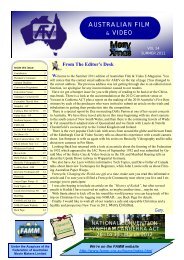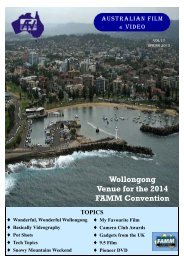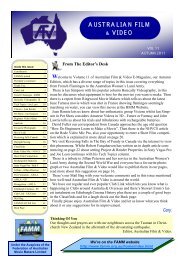Australian film - Federation of Australian Movie Makers
Australian film - Federation of Australian Movie Makers
Australian film - Federation of Australian Movie Makers
Create successful ePaper yourself
Turn your PDF publications into a flip-book with our unique Google optimized e-Paper software.
BASICLY<br />
VIDEOGRAPHY<br />
by Ian Simpson<br />
Composing for the Widescreen<br />
As many <strong>of</strong> us, amateur videographers, make the transition from<br />
capturing video in the 4x3 format to capturing in the widescreen<br />
format <strong>of</strong> 16x9, we are going to go through the same learning<br />
experience as did the cinematographers <strong>of</strong> old when they started<br />
making widescreen <strong>film</strong>s in the 1950s. So it’s <strong>of</strong>ficial, we are<br />
about 50 years behind the pr<strong>of</strong>essional cinema! However, what<br />
can we learn from the pr<strong>of</strong>essional cinematographers that will<br />
shorten our learning curve to widescreen video excellence?<br />
A Must to Avoid<br />
When making your first widescreen video you may be motivated<br />
to fill the frame with as much detail as possible. This<br />
4 x 3<br />
16 x 9<br />
might mean placing as many people in the frame as<br />
possible or it might be having a busy foreground, middle<br />
ground and background. In both instances the images<br />
will confuse the audience with no clear point<br />
gaining the audience’s attention. Alternatively those<br />
videographers new to the 16x9 format may instinctively<br />
compose their images like they did for the 4x3<br />
format. They may centralise the main point <strong>of</strong> interest<br />
or persons in the frame and pay no attention to what is<br />
happening at the edges <strong>of</strong> the frame. In this instance<br />
the result is either a poor composition (a failure to apply<br />
the Rule <strong>of</strong> Thirds effectively) or there may be distracting activities at the edge <strong>of</strong> the frame.<br />
Enhanced View<br />
So the new 16x9 videographers have to look at<br />
this wider frame with new eyes and recognise its<br />
new potential. An <strong>of</strong>f centre object or person can<br />
be balanced by a small area <strong>of</strong> colour or highlight<br />
on the opposite side <strong>of</strong> the frame (again remembering<br />
the Rule <strong>of</strong> Thirds for more powerful<br />
placement <strong>of</strong> the person or object and the area <strong>of</strong><br />
colour). A consequence <strong>of</strong> this type <strong>of</strong> composition<br />
is the placement <strong>of</strong> two related events in the<br />
one frame. By being able to show both activities<br />
occurring within the one frame, the widescreen<br />
directors found they did not have to cut from<br />
scene to scene as <strong>of</strong>ten as they did in the 4x3<br />
The Rule <strong>of</strong> Thirds states that the most dramatic placement <strong>of</strong><br />
key objects is where the yellow lines intersect.<br />
format. Karel Reisz and Gavin Millar expressed this point in their classic book, The Technique <strong>of</strong> Film.<br />
Another compositional technique that is stronger in the 16x9 frame is the diagonal feature that starts at<br />
one corner <strong>of</strong> the frame. None <strong>of</strong> these compositional ploys are unique to the widescreen format, but the<br />
extra width <strong>of</strong> the 16x9 frame emphasises the effect.<br />
An aspect <strong>of</strong> composition that is unique to the moving image is the allowance <strong>of</strong> a moving or looking<br />
room in front <strong>of</strong> the main subject. Here again the wider horizontal <strong>of</strong> the 16x9 frame allows more creativity<br />
in how that space is filled.<br />
Page 14<br />
<strong>Australian</strong> <strong>film</strong> & video










